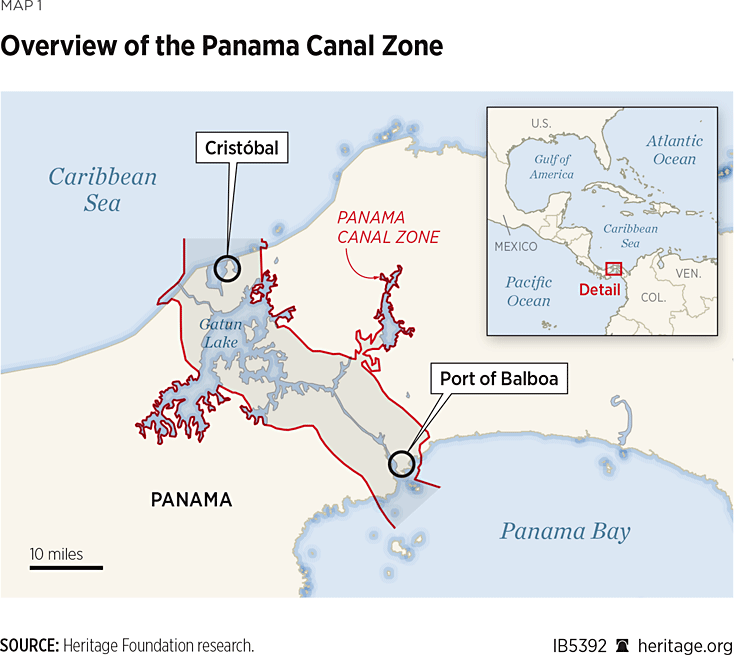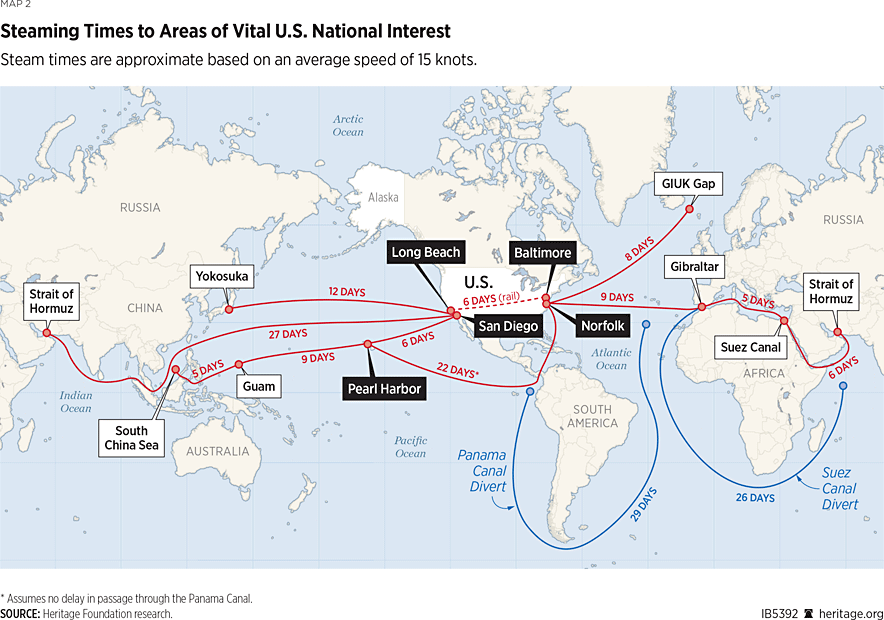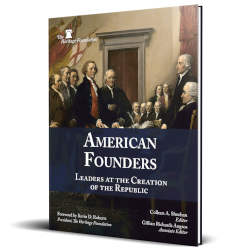Following his re-election, President Donald Trump criticized the government of Panama for its decision to permit the People’s Republic of China (PRC) to exert considerable influence over the Panama Canal. This action was motivated by treaty obligations that address potential threats to the United States’ economy and security that are posed by an adversary nation’s control of a crucial maritime passageway.
In accordance with treaty commitments, President Trump is justified in pursuing both a change of operator for the ports at either end of the Panama Canal and a veto over modifications to or new infrastructure along its length within the adjacent Canal Zone. However, China’s response to President Trump’s intent to ensure American access to the Canal suggests that a more comprehensive approach is necessary.

Current Significance of the Panama Canal for the United States
More than 74 percent of cargo, shipping, and warships transiting the Panama Canal originates from the United States. Consequently, any disruption of this transit would have a profound and detrimental impact on the nation’s economy and security.REF Currently, Hong Kong–based CK Hutchison Holdings Limited operates the Balboa and Cristóbal ports at either end of the Panama Canal, effectively controlling the waterway.REF Infrastructure projects in the Canal Zone (a treaty-bound buffer area)—notably, the construction of a new fourth bridge by the China Communications Construction Company (CCCC) and China Harbour Engineering Company (CHEC), collectively known as the Panama Fourth Bridge Consortium (CPCP)—also could have an impact on canal transit.REF
In light of the inherent risks and historical significance of the canal, which was constructed over a century ago by the United States, President Trump has asserted unequivocally that the United States did not cede the canal to China. His declaration, made during a joint session of Congress on March 5, 2025, underscored his resolute determination to rectify this perilous situation.REF
For a period, an agreement at least to address potential PRC influence over the ports of Balboa and Cristóbal was nearing finalization until Beijing intervened. In early March 2025, President Trump approved a $19 billion deal that would result in CK Hutchison Holdings Limited selling many of its ports, including those in Panama, thereby clearing a $17 billion debt to a consortium led by BlackRock Incorporated.REF Successful completion of this deal would jeopardize a decade-long Beijing strategy to control strategic ports, and it clearly enraged the Chinese government. On July 31, a spokesman for China’s Ministry of Commerce announced that Beijing will oversee any sale of the ports.REF Consequently, a definitive agreement had not yet been reached as of August 21 and is not likely to be finalized before the end of the year.
There are indications that the only sale Beijing would support would be one that includes China COSCO Shipping Corporation, a state-owned entity.REF This is clearly unacceptable, as the inclusion of a Chinese state-owned enterprise in such a deal would exacerbate the threat in Panama. Should control be relinquished to parties favorable to Washington, China or another adversary could choose to close the canal through more direct means.
Lessons from the Ever Given Suez Canal Grounding
As container ships grow ever more massive, it is becoming increasingly difficult to clear accidents promptly in strategic waterways like the Panama Canal. This danger was made evident when the ultra-large container ship the Ever Given grounded on March 23, 2021, closing shipping traffic for 11 days and creating a 360-ship traffic jam that disrupted 13 percent of global maritime trade.
On the day before Ever Given’s grounding, the Eisenhower carrier strike group was in the Eastern Mediterranean conducting operations against ISIS (Islamic State in Syria and Iraq) and was expected to relieve the Makin Island amphibious ready group that was in the Arabian Sea. Had tensions then simmering turned to open conflict as they did a year later in Ukraine, the nearest significant naval carrier strike force (the Theodore Roosevelt CSG) would have had to make a circuitous transit from the Indian Ocean—a danger acknowledged publicly by the Pentagon.REF For a war in the Pacific, the shutting of the Panama Canal would negatively affect military operations by forcing naval vessels in the Atlantic to take an additional 26 days to arrive at the front.

To mitigate such disruptions, the Navy can distribute its forward naval presence—an option that today’s too-small fleet does not have. This makes it imperative that the Panama Canal remains accessible and can be rapidly reopened if blocked. Dealing with the Ever Given incident required a special suction dredger that was able to remove two thousand cubic meters of soil an hour and special heavy-capacity salvage tugs like the Dutch ALP Guard, which took five days to arrive. Such delays in a war with China would carry unacceptable risks.
Treaties Governing U.S. Interests in Panama
The basis for President Trump’s action’s is Article IV of the 1977 Treaty Concerning the Permanent Neutrality and Operation of the Panama Canal between the U.S. and Panama.REF Since the turnover of the canal, it is this treaty that is understood to assure the U.S. that no third party can control access to the canal and the Canal Zone, an area extending five miles from either side of the center point of the canal. On January 28, 2025, international law professor Eugene Kontorovich testified before the Senate Committee on Commerce, Science, and Transportation that the existing situation—specifically, the operation of facilities proximate to the Canal under the control of companies subordinate to a rival or even a hostile China, known for its integration of civilian and military sectors and use of infrastructure development to project global power— can be viewed as a treaty violation.REF
Moreover, the Federal Maritime Commission has recently conducted a review of maritime choke points to include the Panama Canal and the country’s shipping registry, which includes more than 8,000 commercial vessels.REF When the findings are made available, they will provide further insights into violations of this treaty and the potential for wider Chinese maritime industrial and shipping interference.
China’s Control of Ports
Since 2013, the Chinese Communist Party (CCP) under Secretary General Xi Jinping has implemented a global infrastructure investment program called the Belt and Road Initiative. Panama was a participant in this program until March 2025, when it withdrew under pressure from the Trump Administration.REF The danger, however, is still present.
Various institutions have long pointed to concerns about the opaque loan structures behind China’s overseas projects and its Belt and Road Initiative. After China assumed control of Sri Lanka’s Hambantota Port in 2017 “[u]nder heavy pressure” from the Chinese in “one of the most vivid examples of China’s ambitious use of loans and aid to gain influence,” Beijing’s state-led approach to overseas investment came to be known as “debt diplomacy.”REF A report by AidData has detailed how opaque and nefarious debt structures enable Beijing’s collateralization of national or even private debt for Chinese state strategic purposes.REF Moreover, according to the U.S.–China Economic and Security Review Commission, there are various legal and de facto avenues for state control that are further enabled by CCP committees that are present in more than 72 percent of China-based firms to ensure party orthodoxy and execution of party diktats.REF
In short, there is no such thing as private enterprise in China, and any such investment or affiliation must be considered as under the control of the Chinese Communist Party. In recent years, the CCP has also expanded its influence over multinational maritime regulatory bodies.
International Maritime Organization and the Panama Nexus
The International Maritime Organization (IMO) is involved primarily in ensuring safe and environmentally responsible shipping. However, in recent years, the IMO has approved policies that serve Chinese shipping and political interests. Most recently, for example, it has approved carbon-zero policies that would effectively impose a tax on Americans and benefit China’s maritime industry at the expense of others.REF Failure to advocate effectively for U.S. interests at the IMO has resulted in calls to replace the U.S. representative, who oversaw the imposition of onerous mariner credentialing and exhaust standards.REF
It was also during this time that China’s favored IMO chair was elected without objection, furthering PRC influence over this important maritime body. These developments led Lloyd’s List, an influential maritime news outlet, to characterize China as the “default power broker inside the IMO having strategically built a political and technically adept representation, capable of outstripping all other maritime nations inside the [United Nations] system.”REF
Even should the U.S. and Panama work out a new arrangement that ensures treaty obligations and meets U.S. security concerns, China’s ability to impact the shipping that transits the canal must be addressed. One way to ensure that this does not occur would be to enhance the U.S. voice at the IMO by acting in concert with like-minded maritime nations.
Safeguarding America’s Interests
To safeguard America’s interests and counter any attempts by China to oppose reimposition of U.S. control of the Panama Canal and the Panama Canal Zone, the United States needs to:
- Ensure that there is no CCP presence in the Panama Canal Zone. China’s counterproposals for control of ports in Panama only recast and do not ameliorate Chinese Communist Party influence over strategically important infrastructure. The U.S. government must not agree to any deal that allows any China-based or CCP-controlled entities (including entities based in Hong Kong) to maintain a presence in the Panama Canal Zone.
- Work with Panama to establish a minimal military and salvage presence in Panama. Given the potential impact on U.S. military operations, it is prudent to maintain a minimum military presence to augment Panamanian security forces. At the same time, because of the potential for significant economic impact, the U.S. government must ensure that it can rapidly clear obstructions and reopen the canal.
- Reassert U.S. influence in the International Maritime Organization. The IMO plays a key role in setting international shipping standards and cannot be allowed to constrain shipping in a way that is harmful to U.S. interests. Accordingly, the U.S. government should name a new U.S. representative to the IMO as soon as possible. This new nominee would be tasked with aggressively advocating for U.S. interests and rallying like-minded delegates to counter any CCP reprisals for the loss of strategic ports in Panama.
- Form a maritime group of nations. Establish an informal maritime group of like-minded partner nations modeled on the G7 (Group of Seven).REF This body would coordinate engagement in multinational organizations, enhance investment opportunities in critical ports, and work to limit adverse Chinese maritime actions.
Conclusion
As China prepares its response to U.S. efforts to regain control of the Panama Canal, the United States needs a comprehensive global maritime strategy. Most urgent is the need to attract like-minded nations to invest in America’s maritime industry, assure access to critical ports and shipping, and specifically uphold the treaties that govern the Panama Canal. Any deal with Beijing that enables China to maintain a continued presence in the Panama Canal Zone is unacceptable and does nothing to lessen the threat to America’s security interests that China’s presence poses.
Brent D. Sadler is Senior Research Fellow for Naval Warfare and Advanced Technology in the Douglas and Sarah Allison Center for National Security at The Heritage Foundation.



